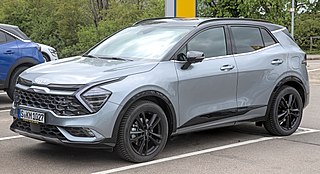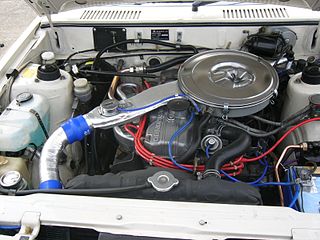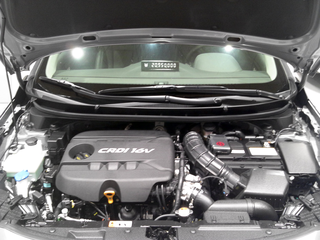
Mazda has a long history of building its own diesel engines, with the exception of a few units that were built under license.

The Hyundai Tucson is a compact crossover SUV produced by the South Korean manufacturer Hyundai since 2004. In the brand's lineup, the Tucson is positioned below the Santa Fe, and above the Kona and Creta. It is named after the city of Tucson, Arizona. The second-generation model was marketed as the Hyundai ix35 in several markets, including Europe, Australia and China, before reverting to Tucson for the third generation. Since its first generation, the Tucson has been developed alongside the Kia Sportage, sharing platforms and engines.

The Kia Sportage is a lineup of sport utility vehicles manufactured by the South Korean manufacturer Kia since 1993 through five generations. Initially a compact SUV built on a body-on-frame chassis, the second-generation Sportage transitioned to a car-based platform which placed it into the compact crossover SUV class, and has been developed alongside the Hyundai Tucson. Since the fifth-generation model launched in 2021, Kia developed the Sportage in two sizes with different wheelbase lengths for different markets.

The Mitsubishi Astron or 4G5/4D5 engine, is a series of straight-four internal combustion engines first built by Mitsubishi Motors in 1972. Engine displacement ranged from 1.8 to 2.6 litres, making it one of the largest four-cylinder engines of its time.

The Mitsubishi Sirius or 4G6/4D6 engine is the name of one of Mitsubishi Motors' four series of inline-four automobile engines, along with Astron, Orion, and Saturn.
The Hyundai Sirius engine was the company's first larger inline-four engine, with displacements from 1.8 L to 2.4 L. It is a license-built Mitsubishi construction. This engine is no longer used by Hyundai.
The Hyundai Sigma engine is a series of V6 piston engines from Hyundai Motor Company, based on the Mitsubishi 6G7 engine. The Sigma engine family began life with the simple V6 name. Displacement ranges from 2.5 to 3.5 L.

The Kia Rio is a subcompact car manufactured by Kia since November 1999 and now in its fourth generation. Body styles have included a three and five-door hatchback and four-door sedan, equipped with inline-four gasoline and diesel engines, and front-wheel drive.

The Hyundai Lambda engine family is the company's all-aluminium V6 engine manufactured since 2005. It is currently manufactured at Hyundai's plant in Asan, South Korea. It used to be manufactured at HMMA plant in Montgomery, Alabama, United States. All versions of this engine use a timing chain.

The Hyundai Theta is a gasoline four-cylinder automobile engine family. The third all-aluminum engine of Hyundai Motor Company debuted in the fourth-generation Hyundai Sonata sedan, which was unveiled in August 2004 in South Korea. Hyundai Motor Manufacturing Alabama (HMMA) built a Theta II engine shop on the grounds of their Montgomery, Alabama automobile factory.

The Kia Sorento is a lineup of sport utility vehicles manufactured by the South Korean manufacturer Kia since 2002 through four generations. Initially a compact SUV built on a body-on-frame chassis, the second-generation Sorento transitioned to a car-based platform which placed it into the mid-size crossover SUV class, and has been developed alongside the Hyundai Santa Fe.
Multijet is Stellantis's term for its current common rail direct injection turbodiesel engine range. Most of the Fiat, Alfa Romeo, and Lancia range, as well as certain Chrysler, RAM Trucks, Jeep, and Maserati vehicles, are equipped with Multijet engines. Ownership of some Fiat Multijet designs is shared with General Motors as part of a settlement of the failed merger between the two auto conglomerates. The GM Powertrain Torino group in Turin, Italy, manages its interest in these engines. Some PSA Peugeot Citroën diesel engines are also rebadged JTD units, and vice versa. Fiat's common-rail diesel engine is also known as JTD, an initialism of Jet Turbo Diesel.

The N series is Honda's first automotive diesel engine, an inline-four for medium-sized vehicles. It uses common rail direct injection, which Honda brands as i-CTDi. The most notable feature is the aluminium block, which uses proprietary technology in the manufacturing process to provide light weight and high rigidity. Roller chains drive two overhead camshafts. A variable-geometry turbocharger and intercooler are used.

The Hyundai Starex is a series of light commercial vehicles built by Hyundai. First-generation models were known in Europe as the Hyundai H-1 and as the Hyundai H200 in the Netherlands. For the second generation, Australian and UK market models are sold as the Hyundai iLoad, in Australia as Hyundai iMax and the UK as Hyundai i800. European models are differentiated as the Hyundai H-1 Cargo and Hyundai H-1 Travel. In the Netherlands, it is called Hyundai H300, in Malaysia, only as Hyundai StarexRoyale with Minivan, while the people mover version of the H300 is sold only for fleets.

The Hyundai U engine is a series of three or four-cylinder diesel engines made for automotive applications by the Hyundai Kia Automotive Group. The U series of engines includes the smallest automotive diesel engines produced by Hyundai.
The Hyundai R engine is a diesel 4-cylinder automobile engine produced by Hyundai Motor Group, it was announced during the Advanced Diesel Engine Technology Symposium in November 2008 and began production in 2009.

The Hyundai Gamma engine was introduced in 2006 to replace the existing Hyundai Alpha engine. There are 1.4 L and 1.6 L versions of this engine.

The Hyundai Smartstream is a gasoline and diesel automobile engine branding used by Hyundai since 2018. An all-aluminum engine of Hyundai Motor Company debuted in the third-generation Hyundai i30 hatchback, which was unveiled in 2018 at the Paris Motor Show.
The Hyundai D engine is a family of 3-cylinder and 4-cylinder diesel engines produced by Hyundai Motor Company under license from VM Motori.













